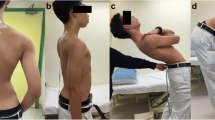Abstract
Background
The determination of factors affecting curve flexibility is important in idiopathic scoliosis patients with regard to the Risser sign. The objective of this retrospective study was to identify factors affecting curve flexibility in patients with skeletally immature and mature idiopathic scoliosis.
Methods
The records of all patients with idiopathic scoliosis who received surgical treatment from July 2001 to August 2008 at our hospital were screened. The Risser sign was used to separate the patients into a skeletally mature group (Risser grade = 5) and skeletally immature group (Risser grade < 5). Data recorded and compared were flexibility (%), bending angle (°), apical vertebral rotation (°), Cobb angle (°), curve location, prior use of brace treatment, and number of vertebrae in the curve.
Results
The study cohort consisted of 217 patients (34 males, 183 females) in the Risser grade < 5 group and 124 (21 males, 103 females) in the Risser grade = 5 group. Multiple linear regression analysis revealed that the Cobb angle and the curve location significantly affected curve flexibility in the Risser grade < 5 group, whereas in the Risser grade = 5 group, Cobb angle and age significantly affected flexibility.
Conclusions
Cobb angle and curve location influence main curve flexibility in skeletally immature adolescent idiopathic scoliosis, and Cobb angle and age influence curve flexibility in skeletally mature adult scoliosis. Measurement of these values may aid in the evaluation of treatment options and preoperative planning.
Similar content being viewed by others
References
Liu RW, Teng AL, Armstrong DG, Poe-Kochert C, Son-Hing JP, Thompson GH. Comparison of supine bending, push-prone, and traction under general anesthesia radiographs in predicting curve flexibility and postoperative correction in adolescent idiopathic scoliosis. Spine. 2010;15:416–22.
Cheh G, Lenke LG, Lehman RA Jr, Kim YJ, Nunley R, Bridwell KH. The reliability of preoperative supine radiographs to predict the amount of curve flexibility in adolescent idiopathic scoliosis. Spine. 2007;32:2668–72.
Deviren V, Berven S, Kleinstueck F, Antinnes J, Smith JA, Hu SS. Predictors of flexibility and pain patterns in thoracolumbar and lumbar idiopathic scoliosis. Spine. 2002;27:2346–9.
Clamp JA, Andrews JR, Grevitt MP. A study of the radiologic predictors of curve flexibility in adolescent idiopathic scoliosis. J Spinal Disord Tech. 2008;21:213–5.
Marks M, Petcharaporn M, Betz RR. Outcomes of surgical treatment in male versus female adolescent idiopathic scoliosis patients. Spine. 2007;32:544–9.
Lonstein JE. Scoliosis: surgical versus nonsurgical treatment. Clin Orthop Relat Res. 2006;443:248–59.
Perdriolle R, Vidal J. Thoracic idiopathic scoliosis curve evolution and prognosis. Spine. 1985;10:785–91.
King HA, Moe JH, Bradford DS, Winter RB. The selection of fusion levels in thoracic idiopathic scoliosis. J Bone Joint Surg (Am). 1983;65:1302–13.
Lenke LG, Betz RR, Harms J, Bridwell KH, Clements DH, Lowe TG, Blanke K. Adolescent idiopathic scoliosis: a new classification to determine extent of spinal arthrodesis. J Bone Joint Surg (Am). 2001;83:1169–81.
Ameri E, Behtash H, Mobini B, Omidi-Kashani F, Momeni B. Radiographic outcome of surgical treatment of adolescent idiopathic scoliosis in males versus females. Scoliosis. 2008;3:12.
Qiu G, Zhang J, Wang Y, Xu H, Zhang J, Weng X, Lin J, Zhao Y, Shen J, Yang X, Luk KD, Lu D, Lu WW. A new operative classification of idiopathic scoliosis: a Peking Union Medical College method. Spine. 2005;30:1419–26.
Cheung KM, Luk KD. Prediction of correction of scoliosis with use of the fulcrum bending radiograph. J Bone Joint Surg (Am). 1997;79:1144–50.
Klepps SJ, Lenke LG, Bridwell KH, Bassett GS, Whorton J. Prospective comparison of flexibility radiographs in adolescent idiopathic scoliosis. Spine. 2001;26:E74–9.
Conflict of interest
The authors declare that they have no conflict of interest regarding this work.
Author information
Authors and Affiliations
Corresponding author
Additional information
Z.-Q. Chen and Y.-F. Zhao contributed equally to this work.
About this article
Cite this article
Chen, ZQ., Zhao, YF., Bai, YS. et al. Factors affecting curve flexibility in skeletally immature and mature idiopathic scoliosis. J Orthop Sci 16, 133–138 (2011). https://doi.org/10.1007/s00776-011-0034-6
Received:
Accepted:
Published:
Issue Date:
DOI: https://doi.org/10.1007/s00776-011-0034-6




